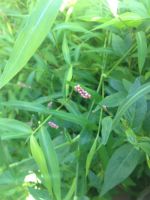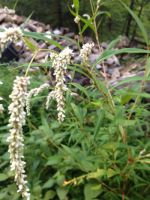The Knotweed Family by Susun Weed
The knotweed, or smartweed, or buckwheat family — the Polygonaceae — is an interesting family that is probably represented by one or more species right outside your door, no matter where you live.  Most knotweeds have terminal (at the upper end) clusters of conspicuous droopy or upright pink or white flowers that are so tightly closed they look like knots. Wild buckwheat and cultivated buckwheat (which is also known as kasha) have flowers like this. Here are a few of the many knotweeds growing within a few steps of my house.
Most knotweeds have terminal (at the upper end) clusters of conspicuous droopy or upright pink or white flowers that are so tightly closed they look like knots. Wild buckwheat and cultivated buckwheat (which is also known as kasha) have flowers like this. Here are a few of the many knotweeds growing within a few steps of my house.
 Other plants in the buckwheat family have small, knotty, green flowers on a stiff upright stalk. One of the most important members of this family, rhubarb, blooms like this. While the leaf stalks of rhubarb are edible and delicious, it is the root that has been revered for centuries as a potent herbal medicine. (Too potent for me, thank you. I will stick to my rhubarb/strawberry pie.)
Other plants in the buckwheat family have small, knotty, green flowers on a stiff upright stalk. One of the most important members of this family, rhubarb, blooms like this. While the leaf stalks of rhubarb are edible and delicious, it is the root that has been revered for centuries as a potent herbal medicine. (Too potent for me, thank you. I will stick to my rhubarb/strawberry pie.)
The constituent that makes rhubarb root a big medicine is also found in yellow dock roots, albeit, thank goodness, in smaller amounts. Where rhubarb root can blast the intestines, yellow dock root, taken regularly, keeps you regular. We’ll be digging yellow dock root in my roots class, October 4 . Right now, we are making yellow dock seed vinegar, as the seeds have many of the same good effects as the roots.
 A near relative of yellow dock is garden sorrel, and her wild sister sheep sorrel. Both have “eared” leaves with a wonderful acidic, tangy taste that brings a smile to my face and a cooling breeze to my brow. Perfect in salads, sorrel leaves also star in cooked dishes such as Shav (sorrel/potato soup). The sheep sorrel bloomed long ago and is now putting out new, young, reasonably-large (for a small plant) leaves. Delicious. Vitamin-C rich. Antioxidant rich. Folic acid rich. Fun plants. Find. Eat. Enjoy.
A near relative of yellow dock is garden sorrel, and her wild sister sheep sorrel. Both have “eared” leaves with a wonderful acidic, tangy taste that brings a smile to my face and a cooling breeze to my brow. Perfect in salads, sorrel leaves also star in cooked dishes such as Shav (sorrel/potato soup). The sheep sorrel bloomed long ago and is now putting out new, young, reasonably-large (for a small plant) leaves. Delicious. Vitamin-C rich. Antioxidant rich. Folic acid rich. Fun plants. Find. Eat. Enjoy.
Get to know a knotweed this week. Eat a bowl of kasha. Green blessings are everywhere.
Copyright Susun Weed www.wisewomanmentor.com
